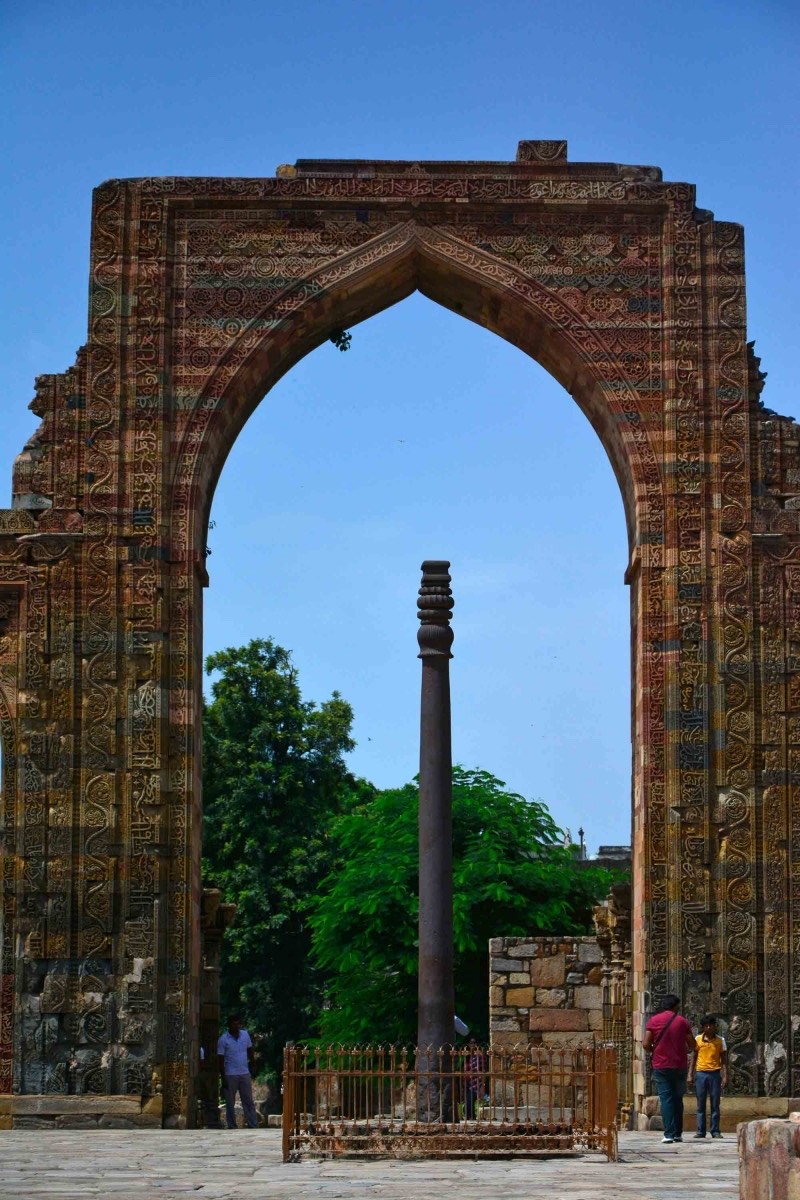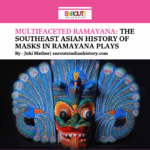Sanderson’s Sundial: Timekeeping and Astronomy in the Qutub Minar Complex
- EIH User
- September 12, 2024

The Qutub Minar Complex in Delhi, known for its majestic architecture, also harbours a lesser-known gem of astronomical significance —Sanderson’s Sundial, a fascinating example of historical timekeeping. Nestled near the exquisite tomb of Imam Muhammad Zamin, this modest yet regal structure is easily overlooked amidst the towering grandeur of the Qutub Minar.
Sundials have existed for centuries, emerging independently in nearly every major culture. These ingenious devices measure time by tracking the light spot or shadow cast by the Sun’s position on a reference scale. As the Earth rotates on its polar axis, the Sun seems to journey across the sky from east to west, rising at dawn, reaching its zenith at noon, and setting in the evening.
Each culture added its twist to the sundial as civilizations advanced. Some designs focused on the Sun’s direction (azimuth), while others tracked its height (altitude). Over time, these sundials evolved, becoming increasingly precise and sophisticated, transforming the simple act of marking time into a beautiful fusion of science and art.
Sanderson’s Sundial, though small, perhaps by design to avoid challenging the majesty of the Qutub Minar, stands in solitary splendour, embodying a quiet regality. It’s tucked away in a corner, and one could easily miss it, yet its presence is a subtle reminder of the British sensibility—where restraint in design speaks volumes, possibly driven by economy or a deep respect for the historical significance of its surroundings.

Sanderson’s sundial
Sanderson’s Sundial is a humble yet captivating relic of historical timekeeping. Carved from pristine white marble, this small yet significant instrument features a slender blade that casts a shifting shadow, tracking the Sun’s journey across the sky. Its design is understated, almost modest, with a minimalistic Latin inscription that reads, “Transit umbra; Lux permanent” — “The shadow passes, the light remains.” Despite its simplicity, Sanderson’s Sundial offers a glimpse into the rich astronomical knowledge that once thrived in India, seamlessly blending scientific precision with the poetic elegance of time’s fleeting nature
A tribute in time
Constructed in memory of Gordon Sanderson, the Superintending Archaeologist of the Archaeological Survey of India (ASI), Sanderson’s Sundial stands as a remarkable tribute to his achievements and illustrious career—a rare recognition in a country where archaeologists and historians are often overlooked. Installed during the late 19th-century British era, this sundial is a fascinating blend of colonial engineering and India’s ancient tradition of astronomical observation. Though it may seem out of place among the ancient structures surrounding it, the sundial is a testament to the enduring legacy of scientific inquiry within the Qutub Minar Complex.

Gordon Sanderson
Sanderson played a pivotal role in the extensive excavations and restoration work within the Qutub Complex, now a UNESCO World Heritage Site. His contributions also extended to the Red Fort Complex, another iconic World Heritage Site in Delhi. Beyond his hands-on work, Sanderson authored several books on India’s architectural marvels and heritage sites. One of his notable works includes a detailed line drawing that imagines what the Qutub Complex might have looked like had all the emperors who initiated various projects there completed them. His legacy, though modestly commemorated by the sundial, continues to echo through the preservation of these historic sites.
Astronomy and the Qutub Minar Complex
The name “Qutub” in Arabic translates to ‘axis,’ ‘pivot,’ or ‘pole.’ It’s a term steeped in both astronomical and spiritual significance, often referring to celestial movements or a central guiding force. The term ‘Qutub Minar,’ therefore, originally signified an astronomical tower, a beacon of observation rather than a monument to a ruler.
The Qutub Minar was likely an observation tower for an ancient observatory established by the renowned astronomer Varahamihira, long before the rise of Islam. This observatory, thought to have been active between the 4th and 6th centuries AD, was a hub of astronomical research where crucial calculations about the movements of planets and stars were conducted, and Vedic theories were tested and validated.

Iron Pillar
Recent research by M.S. Bhatnagar has even suggested that the Qutub Minar, with its aerial view, is a “Dhruv Stambha” or “Vishnu Stambha,” representing the zodiac signs (rashis) and the hours of the day. This implies that the tower was not just a monument but a sophisticated instrument for measuring time and tracking the positions of stars within different zodiac signs.
The Qutub Minar Complex, known primarily for its towering minaret, has always connected deeply to astronomy. The nearby Iron Pillar is believed to be a cosmic instrument, and the alignment of the complex with celestial bodies hints at its historical significance for observation and timekeeping. Sanderson’s Sundial, continues this legacy, subtly weaving the complex’s role in the evolution of time measurement into its narrative. What was once an ancient observatory has evolved into a complex where science, history, and mythology intersect, making the Qutub Minar a timeless axis around which stories of the stars continue to revolve.
Delhi’s Historical Timekeeping Monuments
Delhi, a city steeped in history, is dotted with monuments that have long kept time by the stars, from the Jantar Mantar to the sundials hidden within the Qutub Minar Complex. These structures are more than just architectural marvels; they’re a testament to the city’s enduring relationship with the cosmos and the ever-practical need to measure time. Among these is Sanderson’s Sundial—a relatively recent but significant addition to Delhi’s astronomical heritage, offering a glimpse into how time was perceived and measured across different eras.
Sanderson’s Sundial serves as more than just a marker of the hours; it’s an educational tool that showcases the art of timekeeping before the age of mechanical clocks. With its shadow-casting gnomon, the sundial demonstrates how ancient and medieval societies, including those in India, depended on the Sun’s journey across the sky to track time. Placed within the Qutub Minar Complex, this sundial underscores the continuity of these ancient practices, bridging the gap between the old and the new.
Delhi’s landscape is like a giant tapestry of time, woven together with threads of ancient timekeeping monuments, each with its own unique story. Sanderson’s Sundial is one of these threads, linking the ancient world’s fascination with the heavens to the more precise, modern methods of timekeeping that followed. It stands as a bridge between tradition and modernity, showing us how our understanding of time has evolved—and reminding us that no matter how advanced we become, we still look to the sky to mark our days.
Sanderson’s Sundial at the Qutub Minar Complex stands as more than just a relic of the past; it’s a vibrant symbol of Delhi’s deep-rooted astronomical heritage and the evolving art of timekeeping in India. Nestled within this historic site, the sundial seamlessly bridges the realms of history, science, and culture, drawing our gaze to the sky just as it did centuries ago. Its presence is a reminder of the intricate dance between the cosmos and our understanding of time—a relationship that has not only shaped Delhi’s historical narrative but continues to connect us to the ancient wisdom that still echoes through the city’s timeless structures.
References:-
https://indiancolumbus.blogspot.com/2016/03/sandersons-sundial.html
https://www.myindiamyglory.com/2018/03/23/qutub-minar-vedic-observatory-existing-hindu-motifs-prove/
https://www.sahapedia.org/sites/default/files/styles/sp_inline_images/public/25_9.jpg?itok=Xn3daY7D
https://bpldcassets.blob.core.windows.net/derivatives/images/commonwealth:8s45tk88r/image_access_800.jpg
https://www.sahapedia.org/sites/default/files/styles/sp_inline_images/public/_DSC0205.jpg?itok=Q0jlg6FZ



















